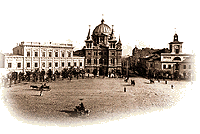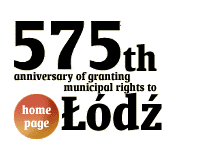|
Lodz is the first city in Poland which, according to the resolution adopted by the Municipal Council in 1919, introduced a general obligatory free school instruction "with the reference to 7-year elementary schools”.
 In 1928 the Branch of Warsaw Free Polish University is opened in Lodz and it gives rise to the foundation of the University of Lodz. The Society of the Friends of Science, founded in 1937, was the beginning of today’s Lodz Scientific Society.
In the years 1919-1939 Lodz remained the city of textile workers, the centre of an industrial district, and the centre of domestic textile industry. It was characterised by considerable national differences. In 1928 the Branch of Warsaw Free Polish University is opened in Lodz and it gives rise to the foundation of the University of Lodz. The Society of the Friends of Science, founded in 1937, was the beginning of today’s Lodz Scientific Society.
In the years 1919-1939 Lodz remained the city of textile workers, the centre of an industrial district, and the centre of domestic textile industry. It was characterised by considerable national differences.
The day before the outbreak of World War II, the city was occupied by approximately 672 000 people, among whom 34.4% were Jewish (231 000 people) and 86 351 Germans.
The realities of Nazi invasion could be felt in Lodz earlier than in other cities. Lodz was included in the so-called “Poznan District” in the III Reich. The name Litzmannstadt was given to the city, and Piotrkowska Street was called Adolf Hitler Strasse.
The first cruel restrictions were imposed on Jews in 1940. Ghetto was created for the Jewish and more than 300 000 people were living there (The liquidation of ghetto took place in August 1944. Only 900 people survived to be free).
The camp for Gypsies was also created as well as the camp for the germanization and extermination of Polish children (there were about 12 000 children kept in that camp, 6 000 of them were tormented to death).
The day before the liberation, on the night of 17/18 January 1945, the Nazis set the Radogoszcz prison-camp on fire. 2 000 of imprisoned people were burnt alive.
In the years of German occupation, 300 000 Jewish people and about 120 000 Polish people were killed.
During the occupation not so many buildings were destroyed in Lodz. The material losses were more serious because the invader took away the machines, raw materials, finished goods etc.
The day before the liberation, about 80 000 Germans left Lodz in panic. At the beginning of 1945 the number of population in Lodz was estimated at 300 000. The most tragic period in the history of the city ends in January 1945. At the end of 1945 there were more than 502 000 inhabitants in Lodz, and in 1951 – 646 000 people living here.
The years between 1945-1948 can be regarded as the period in which the city was fulfilling the function of the temporary capital of the country, because the representations of the authorities were gathered here.
In 1945 the city area was enlarged almost four times (up to 21 150 hectares). The nationalisation of industry, its modernisation, and the change in trade structure took place. Lodz became a big scientific and academic centre. The importance of the city as a cultural centre was increasing as well. The new housing estates were being built. The new industrial plants were coming into existence, the buildings which were to serve science and culture, and the Institutes of Higher Education. The whole infrastructure of the city was changing.
| 


